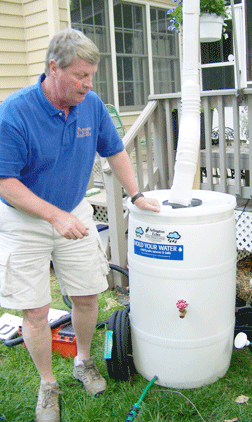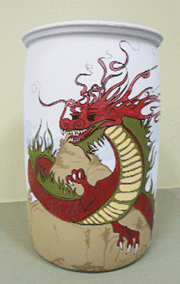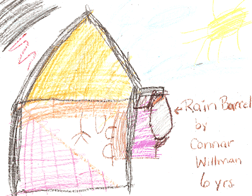Catching the Downspout Deluge
The newest generation of rain barrels fuses fashion with functionby Carrie MadrenAt Suzanne Pogell’s downtown Annapolis home, her gutters and downspouts funneled rainwater into the street and eventually downhill to Spa Creek. Until Pogell bought a rain barrel. When the first rainstorm came, her barrel filled up in a minute. “I thought, I’ve been dumping water in Spa Creek for 30 years!” Pogell said. “Now instead of going down the street, rainwater is going into my garden.” Catching a Barrel o’ RainAt Arlington Echo Outdoor Education Center in Millersville, 96 rain barrels collect water from every building on the 24-acre campus. The environmental center has also made a name for itself as the biggest rain barrel producer in Chesapeake Country. The outdoor education center now makes some 500 rain barrels a month. Steve Barry, Arlington Echo’s director, estimates that they have put some 2,000 barrels around Anne Arundel County. “With a 1,000 square foot house,” Barry says “every storm could fill about 632 50-gallon barrels.” Attached to your downspout, barrels collect water that would otherwise rush downhill to the nearest waterway. Rain barrels buy time for water to seep into the ground. Once water is caught, it doesn’t get out until you open the spigot. If rains fill your barrel, an overflow pipe allows excess water to drain. “It’s important to collect the first flush” of water from a roof, Barry says, “because that’s where most of the pollutants run off.” You’d be amazed, he says, at how much debris, dirt and nutrients wash off of an asphalt roof. So Barry and his staff got into the rain barrel-making business. They use Coca-cola, Pepsi and Domino Sugar barrels, which can’t be reused for food products. The 55-gallon plastic barrels are fitted with a mesh-covered, plastic basket that fits snugly into a hole carved in the top, keeping out debris and mosquitoes — a must for any rain barrel. An overflow pipe on the side near the rim lets water out if the barrel fills. At $60, Arlington Echo’s white, industrial-looking cylindrical barrels with fused lids are a well-made bargain. Other rain barrel makers sell their systems online. The $150 Spruce Creek Rainsaver, moss green or terra cotta, is cast in durable plastic to imitate old-fashioned wooden barrels (www.sprucecreekrainsaver.com). The New England Rain Barrel Company’s signature barrel is a recycled blue plastic fitted with mesh on top, two brass spigots and a hose for $89 (www.nerainbarrel.com). Find full installation directions rain barrel online at www.arlingtonecho.net Art for a Rainy DayBut perhaps — Save the Bay or not — you don’t want a clunky, ugly, plastic barrel at the corner of your house. To do its job, a rain barrel need not be plain.
If a big white, blue or green barrel doesn’t fit into your landscaping, you can spray paint it to match your house — or your trim. Barry recommends Crylon Fusion paint for its wear and adhesiveness to the plastic. Still too plain? Local artists and schoolchildren are dressing up a second generation of rain barrels, combining fashion with function. Young artists at the Balanced Life Skills martial arts school painted and auctioned rain barrels this spring to raise $3,000 for the Chesapeake Bay Foundation. Balanced Life Skills’ head instructor Joe Van Deuren’s students — plus schools, groups and artists — painted 20 Arlington Echo rain barrels. One with an Asian-looking dragon wrapped around it, painted by artist Michelle Wilbricht, fetched $500. “I thought it would be a good way to educate kids and parents,” Van Deuren said. “Normally rain barrels are pretty ugly, but we had five artists,” he says, paint their own and help kids design and paint. Artists were advised to use a waterproof primer and latex paint that could withstand the elements. Among the rain barrel artists was Annapolis illustrator and fine artist Phyllis Saroff. This spring, her contribution was an Asian-inspired koi that fetched some $400. “I wanted to do something bold and fun, and I tried to picture it in someone’s yard,” says Saroff, who catches her rainwater with a homemade rain barrel she fashioned from a Rubbermaid trashcan. To keep out mosquitoes, she puts vegetable oil on the water’s surface and uses the water quickly after the barrel fills. The art departments of a handful of local elementary schools have since borrowed Van Deuren’s idea. Among the first generation of artful students decorating barrels for the auction was seven-year-old Connar Willman, who painted two stenciled dragonflies onto a barrel last fall. Back at home, Connar’s mother, Anna Chaney Willman, asked the young artist what he was drawing. “It was obviously a house, but it had an attachment on it that I couldn’t identify,” she recalled. Connar set her straight: “It’s a rain barrel, Mom.”
|
||||||
|
|
||||||
|
© COPYRIGHT 2008 by New Bay Enterprises, Inc. All rights reserved.
|





